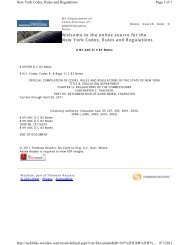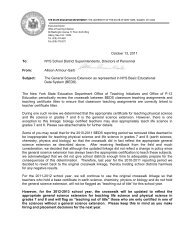ESL Learning Standards - Higher Ed - New York State Education ...
ESL Learning Standards - Higher Ed - New York State Education ...
ESL Learning Standards - Higher Ed - New York State Education ...
Create successful ePaper yourself
Turn your PDF publications into a flip-book with our unique Google optimized e-Paper software.
Standard 5:<br />
Students will demonstrate cross-cultural knowledge and<br />
understanding.<br />
Intermediate Grade Sample Classroom Tasks:<br />
English Proficiency Level<br />
Beginning<br />
Teacher displays pictures showing everyday activities of an<br />
American family (e.g., shopping, registering for school, eating<br />
in restaurant, etc.). Students/teacher talk about pictures<br />
and collect words for each picture. In small groups, students<br />
write a caption for each picture. Students draw pictures<br />
of personal and humorous experiences in the U.S.,<br />
talk about pictures with the class, collect words, and write<br />
a brief caption.<br />
Performance indicators: 3<br />
Intermediate<br />
Students complete Beginning task. Individual or pairs of<br />
students write a skit depicting a personal and humorous<br />
cross-cultural experience. Students form small groups to<br />
refine the skits and perform for the class, paying attention<br />
to intonation, pace, volume, and gestures. Teacher provides<br />
checklist for audience feedback on performances with<br />
attention to indicators. Class and teacher discuss elements<br />
that made the skit humorous.<br />
Performance indicators: 1, 3, 4<br />
<strong>ESL</strong><br />
5<br />
Interm<br />
Students listen to books on tape (e.g., Everybody Cooks Rice<br />
or Everybody Makes Bread) and peruse books to examine<br />
pictures about ways different cultures perform activities<br />
such as cooking or using foods. Each student writes a<br />
question about the book on one side of an index card, and<br />
the answer to the question on the other side. Cards are<br />
distributed and classmates try to answer the questions without<br />
looking at the reverse side.<br />
Performance indicators: 6<br />
Students read/listen to two “Cinderella stories” (e.g., Rough<br />
Face Girl and Lon Po Po) without identifying the stories as<br />
variations of the fairy tale Cinderella. Then they compare<br />
the stories in a Venn diagram. In pairs, students discuss the<br />
common elements/lessons of the stories and report back to<br />
the class. Class reaches consensus on authors’ intent.<br />
Performance indicators: 5<br />
Students listen to books on tape (e.g., Everybody Cooks Rice<br />
and Everybody Makes Bread). Each student brings a recipe<br />
for bread or rice from home, and tape-records his/her<br />
recipe. Each student listens to another’s tape and writes the<br />
recipe. Student compares his/her recipe to the recipe<br />
brought in by the other student, and checks for accuracy.<br />
Recipes are compiled and included in a class recipe book.<br />
Performance indicators: 6<br />
Students complete Beginning task through Venn diagram.<br />
They create a chart of common elements (e.g., magic,<br />
good, evil, happy ending). Teacher divides students into<br />
four groups, and each group reviews one story, looking for<br />
cultural indicators (e.g., clothing, geography, food, housing,<br />
values). Each group presents its findings to the whole class.<br />
Performance indicators: 5, 6<br />
Students brainstorm aspects of their culture (e.g., food,<br />
school, clothes, music), and they distill this list to four topics.<br />
Then they fold a large piece of paper into eight sections<br />
and label each of the top four sections with topics<br />
related to their native culture. They label each of the bottom<br />
four sections with topics related to “U.S. culture.”<br />
Students illustrate examples of the topic and write what<br />
they know about the topic in each square. Then they<br />
report to classmates and solicit questions. Each student<br />
finds answers to questions from books, family, or native<br />
English speakers, and reports back.<br />
Performance indicators: 2, 3, 5<br />
Students complete Beginning task, including both family<br />
and other interviews and reference material. Then they<br />
choose one of the four topics and write a brief comparison<br />
of the two cultures, illustrating their work, for the class bulletin<br />
board.<br />
Performance indicators: 2, 3, 5<br />
84 <strong>Learning</strong> <strong>Standards</strong> for <strong>ESL</strong>
















